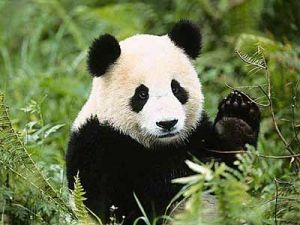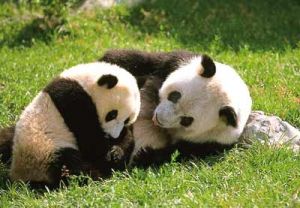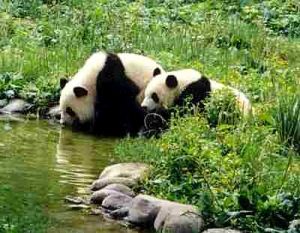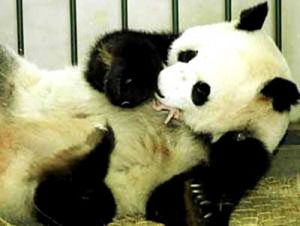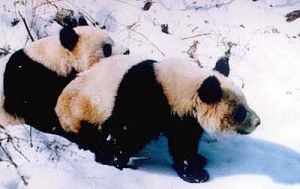Difference between revisions of "Giant panda"
imported>Graceshanshan |
imported>Graceshanshan |
(No difference)
| |
Revision as of 01:19, 27 July 2009
The Giant Panda is universally loved, but this peaceful, bamboo-eating member of the bear family faces many threats. Its population is small and isolated as its traditional forest habitat in southwest China's mountainous areas becomes fragmented. The government has set up more than 30 reserves, but habitat destruction and poaching continues to pose a threat to pandas living outside them. With rapid economic development, it is more important than ever to ensure the giant panda's survival.
Giant pandas are black and white bears that live in temperate-zone bamboo forests in central China. Among the best recognized but rarest animals in the world, they have come to symbolize endangered species and conservation efforts.
| Kindom | Animalia |
| Phylum | Chordata |
| Class | Mammalia |
| Order | Carnivora |
| Family | Ursidae |
| Genus | Ailuropoda |
| Species | A.melanoleuca |
Contents
Scientific Classification
(Genus and Species, Family, Order): Ailuropoda melanoleuca, Ursidae, Carnivora.
Geographic Distribution
Giant pandas live in a few mountain ranges in central China’s Sichuan, Shaanxi, and Gansu provinces. They once lived in lowland areas, but farming, forest clearing, and other development now restrict giant pandas to the mountains.
Habitat
Giant pandas live in broadleaf and coniferous forests with a dense understory of bamboo, at elevations between 5,000 and 10,000 feet. Torrential rains or dense mist throughout the year characterizes these forests, often shrouded in heavy clouds.
Physical Description
A giant panda is bear-like in shape. It has black fur on ears, eye patches, muzzle, legs, and shoulders. The rest of the animal's coat is white. Although scientists do not know why these unusual bears are black and white, some speculate that the bold coloring provides effective camouflage into their shade-dappled snowy and rocky surroundings. The panda's thick, wooly coat keeps it warm in the cool forests of its habitat. Giant pandas have large molar teeth and strong jaw muscles for crushing tough bamboo. Many people find these chunky, lumbering animals to be cute, but giant pandas can be as dangerous as any other bear.
Size
About the size of an American black bear, giant pandas stand between two and three feet tall at the shoulder (on all four legs), and reach four to six feet long. Males are larger than females, weighing up to 250 pounds in the wild. Females rarely reach 220 pounds.
Status
The giant panda is listed as endangered in the World Conservation Union's (IUCN's) Red List of Threatened Animals. It is one of the most critically endangered species in the world. There are about 1,000 left in the wild. About 140 pandas live in zoos and breeding centers around the world, mostly in China.
Life Span
Scientists are not sure how long giant pandas live in the wild, but they are sure it is shorter than lifespans in zoos. Chinese scientists have reported zoo pandas as old as 35.
Diet
A wild giant panda’s diet is almost exclusively (99 percent) bamboo. The balance consists of other grasses and occasional small rodents or musk deer fawns. In zoos, giant pandas eat bamboo, sugar cane, rice gruel, a special high-fiber biscuit, carrots, apples, and sweet potatoes.
Social Structure
Adult giant pandas are generally solitary, but they do communicate periodically through scent marks, calls, and occasional meetings. Offspring stay with their mothers from one and a half to three years.
